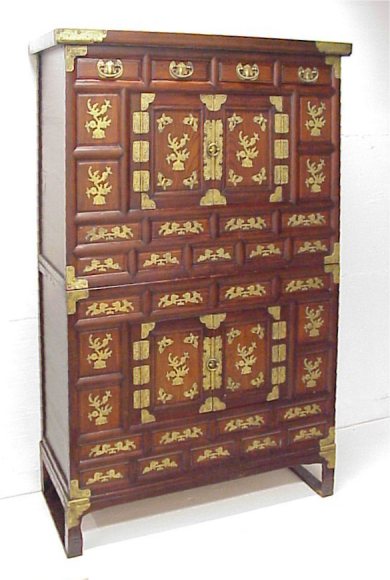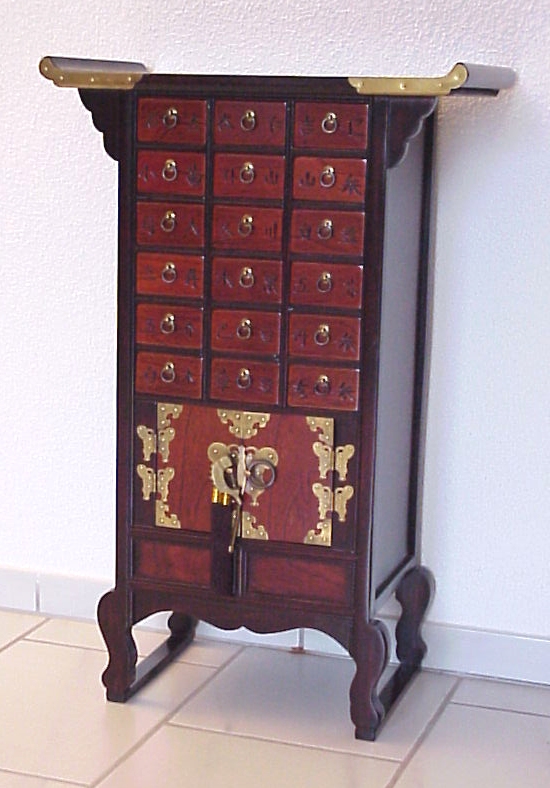Iron, brass and nickle or white
brass were used for locks, handles, hinges, decorations and structural braces. Cut-out and
etched brass fittings and locks were superbly designed and crafted for each chest or box.
Locks were things of beauty quite apart from their utilitarian purpose. Silver locks
inlaid with gold, black iron inlaid with silver, brass carved into the shapes of
propitious animals and fish, and octagonal locks with the characters for prosperity and
long life were made in various sizes. Most locks are of a padlock design to hold together
two links or rings affixed to doors.
Iron decorations were used in kitchen pieces, for it was obvious that brass tarnished
quickly from the carbon monoxide of the cooking fire.
|
 |
We think of the wardrobe as a place to hang our clothes. But it
would be more accurate to speak of Korea's traditional wardrobe as
a place to pile clothes. ln
Korea's wardrobe the clothes are folded and stacked on top of each
other. That is why, when we look inside, we sometimes feel we are
looking down into the depths of a well. Indeed, when we step back
and observe those clothes piled on top of each other, we are
reminded of the earth's geological strata. We might equate the
deepest layer, way at the bottom, with the earth's core, and the
top of the stack with the earth's surface.
|
|
| Each layer
has its own special nature. In the summer, the layer way down at the
bottom is winter clothing, but after a few months has passed, look again
-now the summer clothing is buried down there. And the layers in the
middle will hold clothing for the more temperate months. So the strata
revolve according to the revolution of the seasons.
It is not only seasonal change that determines
what is on the floor of the wardrobe. The very difficulty involved in
pulling something out from way down inside there affords a place to secure
the family's valuables. Embedded in the deepest fathoms of the wardrobe we
will find the anchor which stabilizes and secures the family through the
storms that life will now and then send its way.
That is why, though the Korean wardrobe is not all
that high, its depth is an abyss. One cannot locate the valuables stored
in the wardrobe simply by opening it up and looking inside. The clothing
covering these valuables has to be taken out, piece by piece. The Korean
wife or mother looking for some valuable can resemble some prospector
digging away shovel by shovel, or the pearl diver pushing down, down and
around among the coral reefs. Whether it be a worn out piece of clothing
or some yellowing family photo, each item uncovered during the search
receives a special greeting in the mother's smile, or in her sigh. This
welcome can sometimes come close to the exclamations an archeologist will
utter in the process of excavating an ancient tomb. In the depths of the
wardrobe are things lost to time, forgotten in life's forced march,
naturally receiving a special welcome when they surface again and beckon
us to stay a bit and remember.
This stratified structure is inherent in every
Korean chest no matter what kind or size of chest it is. It does not have
to be a fullsized wardrobe. It may be the chest for boot socks, which
looks like a child's miniature of the larger wardrobe, but has that same
indeterminable depth. Whether it is a chest divided into several
compartments, like the wardrobe, or of just one cavity with nothing more
than its floor to serve as its one and only "shelf," any Korean
chest has its layers and its bottomless bottom.
The wardrobe does not come in only one size or
type. The feature which best distinguishes one wardrobe from another is
the number of levels it has, and we name them accordingly. There is the
two-shelf wardrobe, the three-shelf wardrobe, and so on. As the eye
follows these shelves up or down, as it alights on each of the shelves and
on the layers of clothing stacked on them, one begins to sense a regular
rhythm there. Then again, in each wood shelf nature provides an irregular
pattern in the grain of the persimmon tree or the paulownia. We can see in
this regular rhythm and irregular pattern the beauty of a mosaic, and this
mosaic is enhanced by the varied patterns and colors of the clothes
stacked several high on each shelf.
The Korean wardrobe is a composition of a simple
rhythm weaving colors and textures into a mosaic of life. Though its
contents are not locked up as if in a safe, they are protected from prying
hands by the wardrobe's ever revolving depths. Never locked, in its
fathomless depths it nevertheless safeguards its most precious things, as
does the heart of the Korean mother.
|
The design of furniture was
dictated in part by the designs and styles prevalent in the place of construction, the
regional climates, and by the traditional shapes and decorations associated with usage. As
people began to travel, some geographically dictated distinctions began to blur. But
origin is usually identifiable by the wood work and the differences in ornamentation.
Cholla-do was a rich farming
area. Here various woods were found and the furniture were of excellent quality. Persimmon
was frequently used for the furniture of wealthy land owning farmers.
Kyungsang-do also produces furniture of many woods and brass ornaments of superb quality
as this province too was the home of yangban families.
Chungchung-do was the seat of many aristocratic families. Dignified furniture, often made
of paulownia, was produced in this area.
Kangwon-do furniture are of many stylers reflecting the influences of the other provinces. It was here that officials
took refuge when dismissed from government service. Many brought their household
possessions which local craftsmen would copy.
The Kyunggi area surrounds the capital, Hanyang, where furniture were made for the great
palaces, for the court and the important official families attached to it. But many
furniture are of pine, few other wood being readily available.
|

Ganghwa
island Dolmens |
Ganghwa island, where royalty fled
from Seoul to escape foreign invasions, also produces exquisite
furniture pieces elaborately covered with brass ornaments.
The greater area of Ganghwa consisting of 29
islands in the Yellow Sea. Farming, especially ginseng and rice as well
as fishing are important. The largest island was briefly the site of the
Korean capital in the 13th cent. It was early fortified as an outer
defence for Seoul and was stormed and occupied by the French in 1866 and
by the Americans in 1871.
|
Farther north, in what is now North Korea, little wood other than pine covered the hills.
The craftsmen used whatever was available, covering most of the surface of the furniture
with metal ornaments. |




